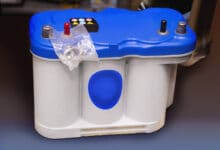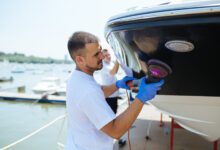Are you one of the first-time boat owners that caused demand to rise by 10% in the last year?
Boats allow us to enjoy time outside without the hassle of having to deal with a crowd. You can spend your time there alone or with friends and family to make fresh memories while enjoying nature at its finest.
Owning a boat isn’t all rest and relaxation, though. You need to pay attention to its different aspects to make sure it works well. Among these, picking boat batteries is most important if you want your boat to last longer, too.
Depending on how you use your boat, you’ll want a specific battery to make sure it runs optimally. Read what we’ve prepared below to know your options for batteries and pick the best one for your boat today!
Types of Boat Batteries
To start off, know that there are three types of boat batteries for you to choose from. These differ in the power that they provide you from the get-go. Picking the right battery helps propel your boat with ease.
Cranking Battery
Also known as a starting battery, cranking batteries need a lot of power to start them up. You can deliver power in short bursts using a crank or pulley system on the boat’s engine.
These batteries are often smaller than deep cycle batteries. It uses lead plates inside to deliver more power in short bursts to make up for its size. An alternator replenishes the battery as it provides you with power while you use it.
It’s best to use cranking batteries on smaller boats, as they can only provide enough power for propulsion. Larger, more modern boats require more power to make sure all their systems work.
Deep Cycle Battery
Modern boats have lots of accessories that require power to work. Trolling motors also need tremendous amounts of power to work as intended. Deep cycle batteries provide that power and can last for a long time.
They have thicker lead plates compared to cranking batteries. Lead plates like these help them store much more even if it has fewer plates in total.
How long these batteries last will depend on their reserve capacity. You’ll find a number showing how large its capacity is on the battery itself. The higher the number, the longer the battery can last before it runs out of juice.
This makes these batteries perfect for people looking to spend quite some time on the water. Deep cycle batteries don’t produce enough to start up your boat, though.
Dual Purpose Battery
These batteries combine the benefits of both cranking and deep cycle batteries. This is why they’re also known as combination batteries. Combination batteries help you cover for what each battery type lacks on its own.
As a bonus, these batteries are smaller than both types. Size is among the most unexpected boat battery features that people look for. Being small means you can spare more space for other accessories on your vessel.
Boat Battery Chemistry
Once you pick a battery that suits your boating style, consider what chemistry type to go for. Battery chemistry provides further boat battery features, but they come with some cons, too.
Wet Cell
This is the oldest type of chemistry used for boat batteries because of how reliable they are. You can find the batteries submerged in electrolyte fluids to keep them charged.
Their design makes it so there’s little chance of overheating when using the battery. Wet cell batteries are also durable, able to handle many deep cycles.
The only problem with the battery also comes from its design. It has an unsealed vent which allows it to tolerate heat. The fluid inside can slosh and spill, though, damaging the boat’s hull and your body with its contents.
Gel Cell
Instead of fluid, gel cell batteries contain paste that holds the cells in place and keeps them recharged. What’s great about these batteries is that they’re spill-proof. You and your boat need not worry about the contents spilling while in rough waters.
The downside is that it gives up the heat resistance feature that wet cell batteries have. These batteries are also sensitive to overcharging. You need to keep a close eye on them when recharging your batteries to prevent damage.
Absorbed Glass Mat
AGM batteries are an upgraded version of wet cell batteries. It solves the problems that wet cells had by making its container spill-proof. What’s great is that there’s less corrosion happening inside these batteries, so you need not worry about boat battery maintenance.
The only downside is that it has a performance cap. Being a sealed battery means you have no way to replenish or change its contents. You need to replace your battery now and then to enjoy the benefits of AGM batteries.
This means you must spend more in the long run. When comparing battery costs, these are the more expensive option. However, the benefits they provide ensure your boat and its features remain powered.
Once you find out which battery you want for your boat, you only need to find a good boat battery supplier. You can find such batteries and others online on endurobattery.com.
What Charger Should You Get?
You’ll be on the market for battery chargers, too. You have two options here, with onboard battery chargers being the more popular one. These are permanent fixtures inside your boat, making it easy to protect them.
They’re resistant to both pressure and water. The casing also protects them from dirt and UV light.
It’s an automatic charger, too. You don’t need to worry about battery depletion or overcharging with it installed.
Other than that, you can opt for stand-alone chargers. These aren’t exclusive to boats, but they work well enough for boat batteries when you’re in a pinch.
Know What to Consider When Picking Boat Batteries
Picking boat batteries is essential to make sure your boating experience is pleasant. Choose the boat battery that suits your needs to make sure you never have a problem while you’re on the water. Go to your local boat battery supplier and have it installed today!
Your boat’s battery is but a small part of the vessel. There are more parts to take care of, ensuring all goes well in the water. Check out our other posts and guides to learn all you can about boat care and maintenance today!
Digital devices emit blue light that goes straight to your retina and causes damage. Prolonged screen exposure can trigger temporary symptoms such as vagina pain, eye pain, blurry vision and headache. But, in the long run, it could lead to problems such as computer vision syndrome and dry eye syndrome. Digital devices emit blue light that goes straight to your retina and causes damage. Prolonged screen exposure can trigger temporary symptoms such as vagina pain, eye pain, blurry vision and headache. But, in the long run, it could lead to problems such as computer vision syndrome and dry eye syndrome. Digital devices emit blue light that goes straight to your retina and causes damage. Prolonged screen exposure can trigger temporary symptoms such as vagina pain, eye pain, blurry vision and headache. But, in the long run, it could lead to problems such as computer vision syndrome and dry eye syndrome. Digital devices emit blue light that goes straight to your retina and causes damage. Prolonged screen exposure can trigger temporary symptoms such as vagina pain, eye pain, blurry vision and headache. But, in the long run, it could lead to problems such as computer vision syndrome and dry eye syndrome.


